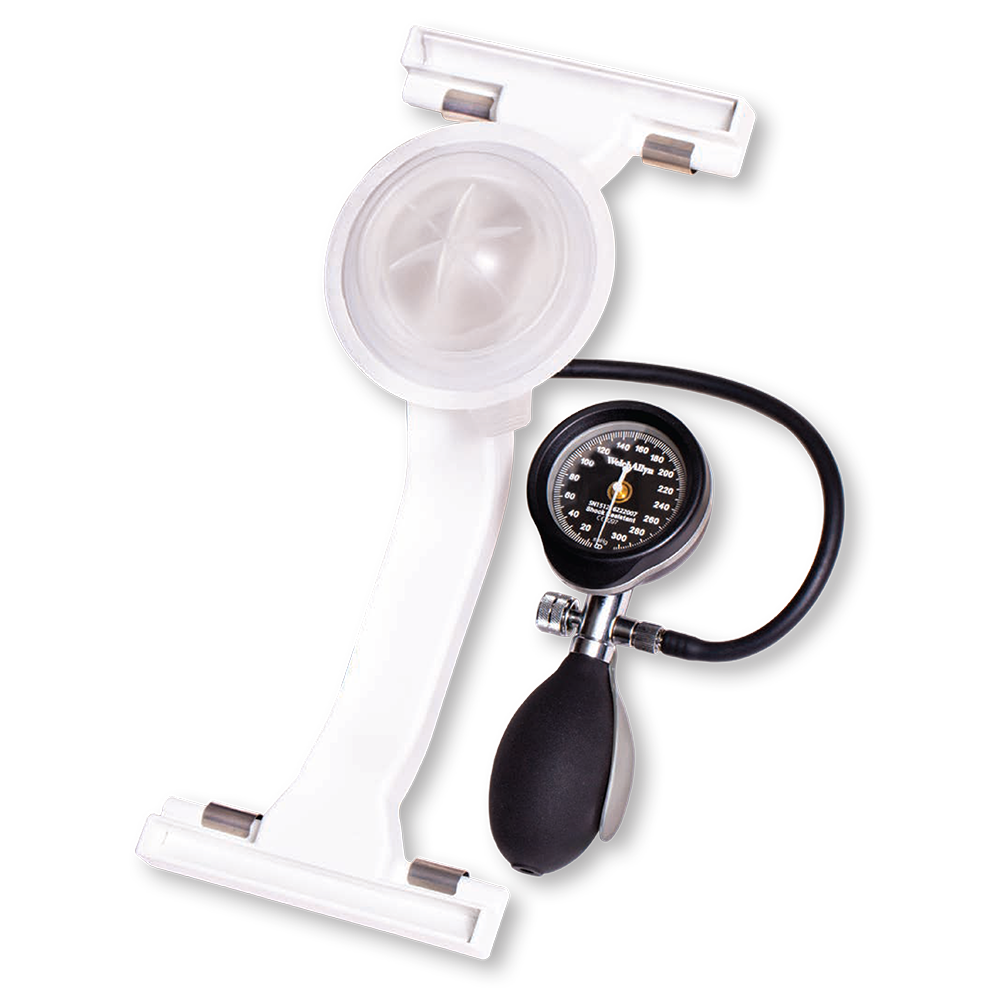
Proven Hands-Free Compression Offers Precise, Efficient Hemostasis
The FemoStop™ II Plus Femoral Compression System (FCS) offers precise, effective hemostasis management using hands-free compression of the femoral artery or vein and has been shown to reduce the incidence of peripheral vascular complications compared to manual compression.1
Since the inflatable dome allows for accurate initial placement and offers precise pressure, the FemoStop™ II Plus system allows for sustains blood flow to the distal extremity for improved patient comfort compared to manual compression.
Fully Integrated Femoral Compression System
Offers Precise Placement and Control
- Precision-controlled manometer allows continuous, measurable pressure which can be adjusted based on patient status.
- Inflatable, transparent dome offers precise pressure for improved patient comfort compared to manual compression.
Improves Staff Efficiency and Safety
- Hands-free compression allows multiple patients to be monitored at one time, increasing staff efficiency.
- The adjustable belt fits securely so that small patient movements may not cause the device to slip.
- Hands-free compression minimizes staff exposure to blood and reduces neck, arm and wrist fatigue.
- The device arch and manometer are easily cleaned and reusable, saving product and packaging materials.
| Component | Function |
|---|---|
| Manometer | Provides user-guided pressure control |
| Pneumatic Pressurized Dome | Translates pressure from manometer to femoral access site |
| Belt | Stabilizes device position and placement |
| Compression Arch | Connects pneumatic pressurized dome, manometer, and belt |
| Bilateral Adapter | Enables simultaneous compression of both the right and left femoral vessels |
Deployment
- Position belt in line with puncture site(s), equal on both sides.
- Attach dome. Peel back lid, keeping the dome sterile.
- Center dome over arterial puncture (superior and medial to skin incision). Keep sheath hubs clear of dome rim.
- Attach belt to arch and fit snug. Ensure arch is level and square across the groin area. Adjust by pulling on appropriate corner of belt to make arch perpendicular to femoral compression site.
- Attach manometer and tubing
- Inflate dome to 20-30 mmHg; then remove venous sheath* (if applicable).
- Further inflate to 60-80 mmHg and remove arterial sheath (if applicable). Then quickly increase pressure in dome to be +10-20 mmHg greater than systolic BP or higher as necessary to maintain initial hemostasis.
- After 3 minutes maximum; lower to a maintenance pressure until limb profusion is restored to baseline and hemostasis is maintained. Check pedal pulse periodically to confirm whether or not flow remains in vessel. After appropriate duration as defined by hospital guidelines; lower by 10-20 mmHg every few minutes until you reach zero. Leave in place at low pressure if appropriate. Remove carefully. Dress wound. Discard device.

Ordering Information
| FemoStop™ II Plus Femoral Compression System | ||
|---|---|---|
| Part Number | Description | Quantity |
| 11168 | FemoStop™ II Plus Support Arch | 1 per box |
| 11169 | FemoStop™ II Plus Bilateral Adaptor | 1 per box |
| 11170 | FemoStop™ II Plus Manometer | 1 per box |
| 11166 | FemoStop™ II Plus Set - Disposables:
| 10 per box |
FemoStop™ II Plus Femoral Compression System — Instructions for Use (IFU). Refer to the IFU for additional information.
References
- Sridhar K, Fischman D, Goldberg S, et al. Peripheral vascular complications after intracoronary stent placement: prevention by use of a pneumatic vascular compression device. Cathet Cardiovasc Diagn. 1996;39(3):224-229.
MAT-2204319 v1.0
